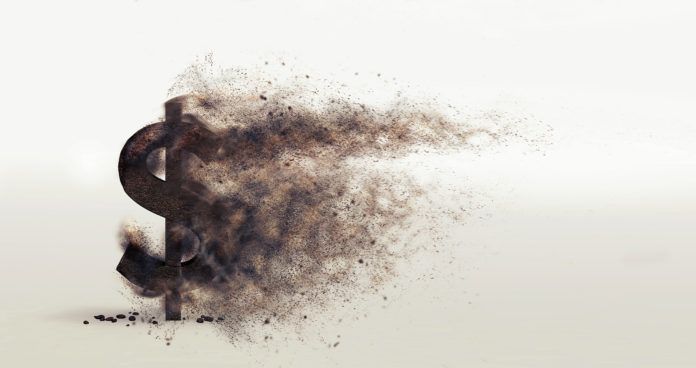Like a rock tossed into a pond, the expansive industry in Louisiana has a nearly immeasurable ripple effect on the economy. This is particularly true for state and parish governments, where financial coffers traditionally derive large chunks of money from oil and gas severance taxes, royalties, corporate income taxes and property taxes.
So some question why Louisiana’s economy is struggling and the state budget is imbalanced even as the petrochemical industry booms and oil and gas rebounds into $70-per-barrel territory. In 2017, the state posted the worst economic performance of all 50 states and was one of only three states where the economy shrank.
According to a report by the U.S. Bureau of Economic Analysis, Louisiana’s gross domestic product contracted by 0.2% in 2017, getting smaller for the second straight year. And the state’s $246 billion economy remains nearly 6% smaller than its 2010 peak, after adjusting for inflation.
In some respects, the leading cause for the dismal GDP is easily traceable. When oil bottomed out in 2015, the industry largely abandoned the offshore and inshore markets for shale plays in Texas and elsewhere. Therefore, even as oil prices rebounded, production continued to lag. Greg Albrecht, chief economist in the Louisiana Legislative Fiscal Office, says the state is still dependent upon oil and gas, but that dynamic is changing. “We have a declining amount of extraction going on in the state in terms of volumes coming out of the ground.”
It’s all about the oil, says Gifford Briggs, president of the Louisiana Oil & Gas Association. “Production in Louisiana has been in a steady decline, much more so in the past four to five years, and so the price of a barrel of oil doesn’t quite have the impact on the state economy that it used to,” Briggs says. “We used to see $80 oil in Louisiana and we’d be dancing in the streets. Here we are at $80 and we’re still talking about huge deficits.”
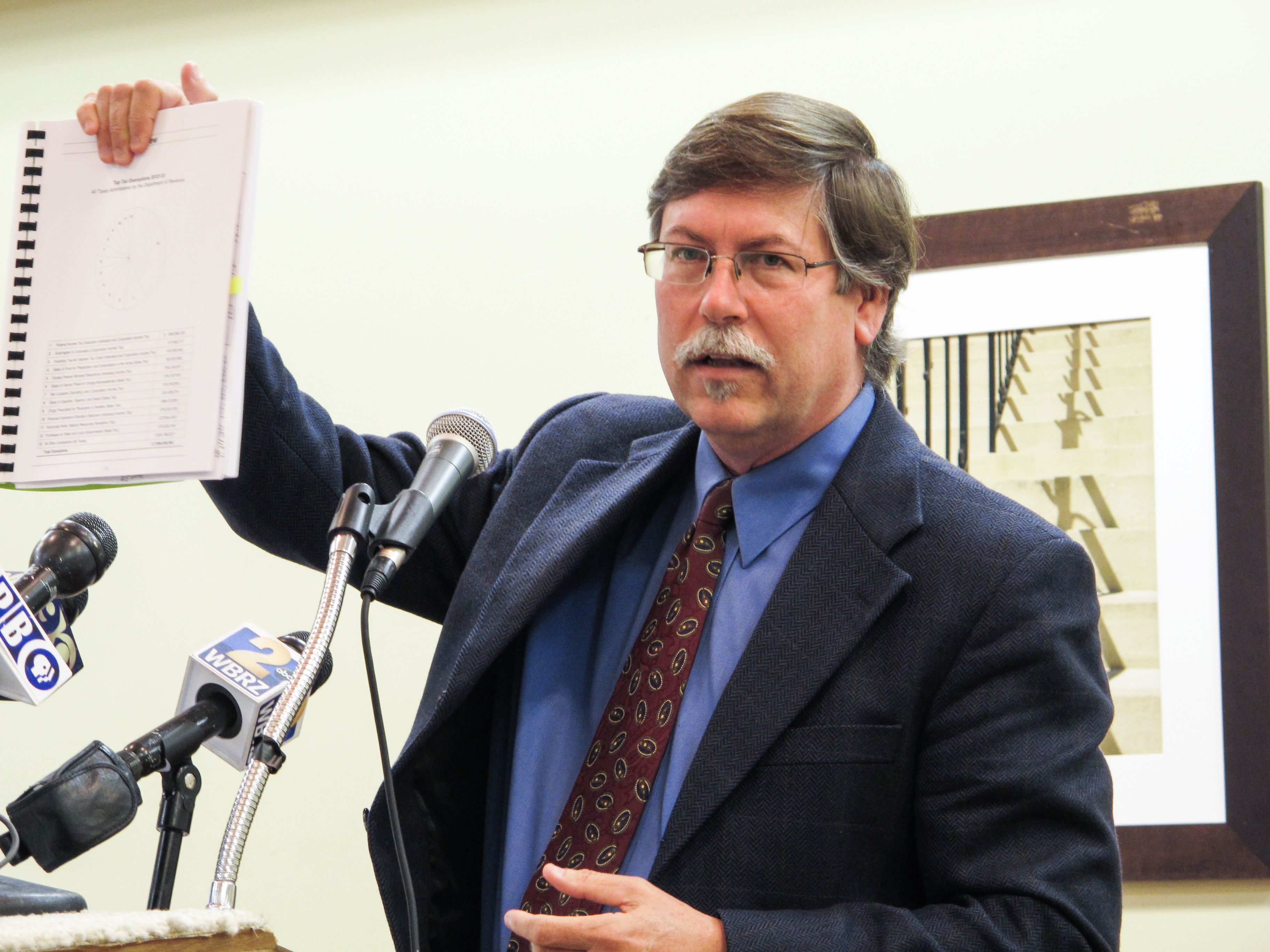
Greg Albrecht, chief economist, Louisiana Legislative Fiscal Office. Photo by The AP.
He says production is also being thwarted by the prevalence of “legacy lawsuits” in Louisiana, whereby landowners can require oil and gas companies to pay for the restoration of their properties. The number of suits increased significantly following a 2003 Louisiana Supreme Court decision allowing plaintiffs to recover the cost to restore a property to its original condition, regardless of the property’s value.
Combined with Louisiana having the highest severance taxes in the U.S., Briggs says “it doesn’t make a lot of sense for companies to spend their very limited capital dollars in Louisiana.”
Inshore costal Louisiana is seeing the biggest impact. Lafayette and Houma have been in the top three for job losses since 2014, Lafayette losing $10 billion in GDP since 2014 with 50% of it coming directly in oil and gas. Coastal use permits, a good indicator of future activity, peaked at about 1,800 in 2013 then dropped by 37% through the end of 2017.
“Oil is a finite resource, so as these wells deplete we need to keep adding new wells to offset the loss of production,” Briggs says. “That’s a huge source of revenue for the state.”
Economist Loren Scott of Loren C. Scott & Associates says instability is an unavoidable reality for oil and gas states, and the cyclical nature of the market makes it difficult for state and parish governments to manage their budgets. Even though oil and gas revenue comprise only about 5% of state government’s operating budget today—it was more than 40% in the 1970s and early 1980s—the drop in oil prices in 2014 had an undeniable effect.
“It adds a level of volatility that most states don’t experience,” he adds. “If you look at Alabama or Mississippi, you would not find their employment numbers moving around quite as much. The problem is the industry depends so much on the price, and the price depends so much on what individual countries do. It’s something that’s not predictable.
“Who would have guessed in the latter part of 2014 that they would just suddenly open the taps and drive the price down from $110 to under $30 a barrel?”
For Louisiana, the real sticking point has been the significant decline in offshore production. “Offshore has never really come back,” Albrecht says. “We had more than 100,000 people in the oil and gas industry in the late ’70s and early ’80s. Then, we were at about 50,000 or so before the 2014 oil drop began, and now we’re down to 30,000 to 35,000.”
GAUGING PETROCHEM
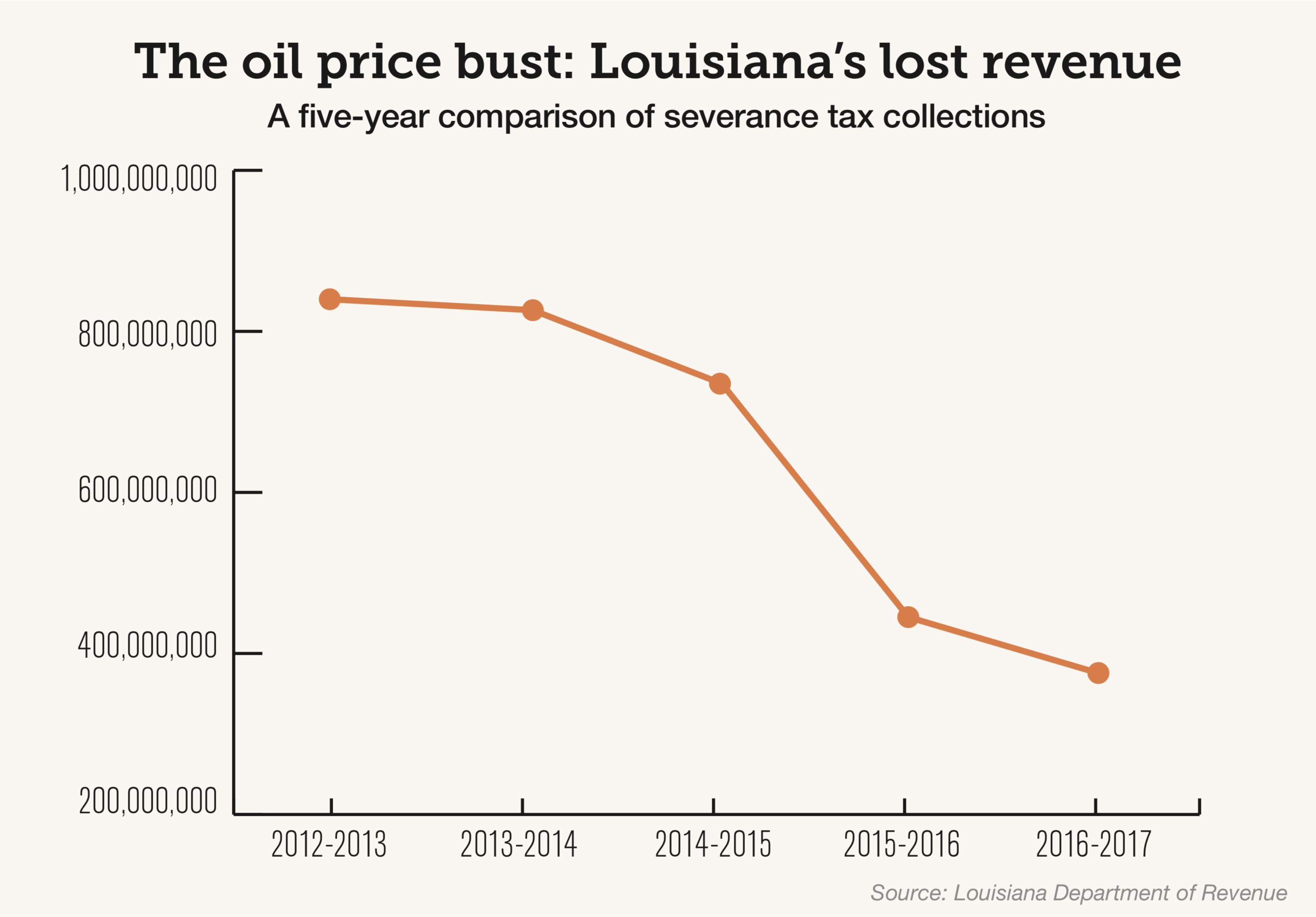 Taking up the slack in a big way has been the petrochemical industry and its recent surge in expansion activity. “In 2016-17, the 192 corporate income tax filers with taxable incomes greater than $10 million paid 65.22% of the total tax liability,” Albrecht says. “Petrochemical is a big part of that.” At the parish government level, petrochemical companies pay out large sums in property taxes—even with exemptions provided by the much-debated Industrial Tax Exemption Program (ITEP).
Taking up the slack in a big way has been the petrochemical industry and its recent surge in expansion activity. “In 2016-17, the 192 corporate income tax filers with taxable incomes greater than $10 million paid 65.22% of the total tax liability,” Albrecht says. “Petrochemical is a big part of that.” At the parish government level, petrochemical companies pay out large sums in property taxes—even with exemptions provided by the much-debated Industrial Tax Exemption Program (ITEP).
Scott estimates that more than $14.5 billion in industry investments in Louisiana will come onto the local property tax rolls during the next four years. Local governments will experience increased tax revenue for parish services, public safety and education because of these investments by industry, not to mention the jobs and local business partnerships that come with these projects.
Still, Albrecht thinks the initial benefit from petrochemical investment is somewhat inflated, given that much of the work is performed overseas. “Those impact analyses that come out of Louisiana Economic Development and local economists grossly overstate the actual impact to the community and the area. Sasol (in Lake Charles) was a huge total investment number, but very large chunks of that facility are actually built and constructed overseas and then shipped in on barges.
“That’s where a lot of the value comes. What we’re doing is assembling it here. Your economy’s not getting $16 billion worth of impact, you’re getting a fraction of that.”
The plants have far more construction employment than operating employment, so once construction is complete, the employment numbers drop dramatically. Regardless, Albrecht says there are obvious benefits to the state. “They make all kinds of products, chemicals and intermediate products, and we export it out to the rest of the world. So it’s a plus for us.”
The long-term benefits are hard to ignore, Scott says, adding that the chemical industry contributes enough money to local governments to pay the salaries of 40% of Louisiana’s public school teachers—at least $959.5 million annually.
Greg Bowser, president of the Louisiana Chemical Association, says the impact of industry is far reaching. “You look at the Turners of the world, the ISCs of the world, and the people they put to work. And then look at the taxes and fees that go to the state treasury. Our estimates show that more than $1 billion [in 2017] goes to state and local governments, in terms of fees and taxes.”
WHAT LOUISIANA GETS
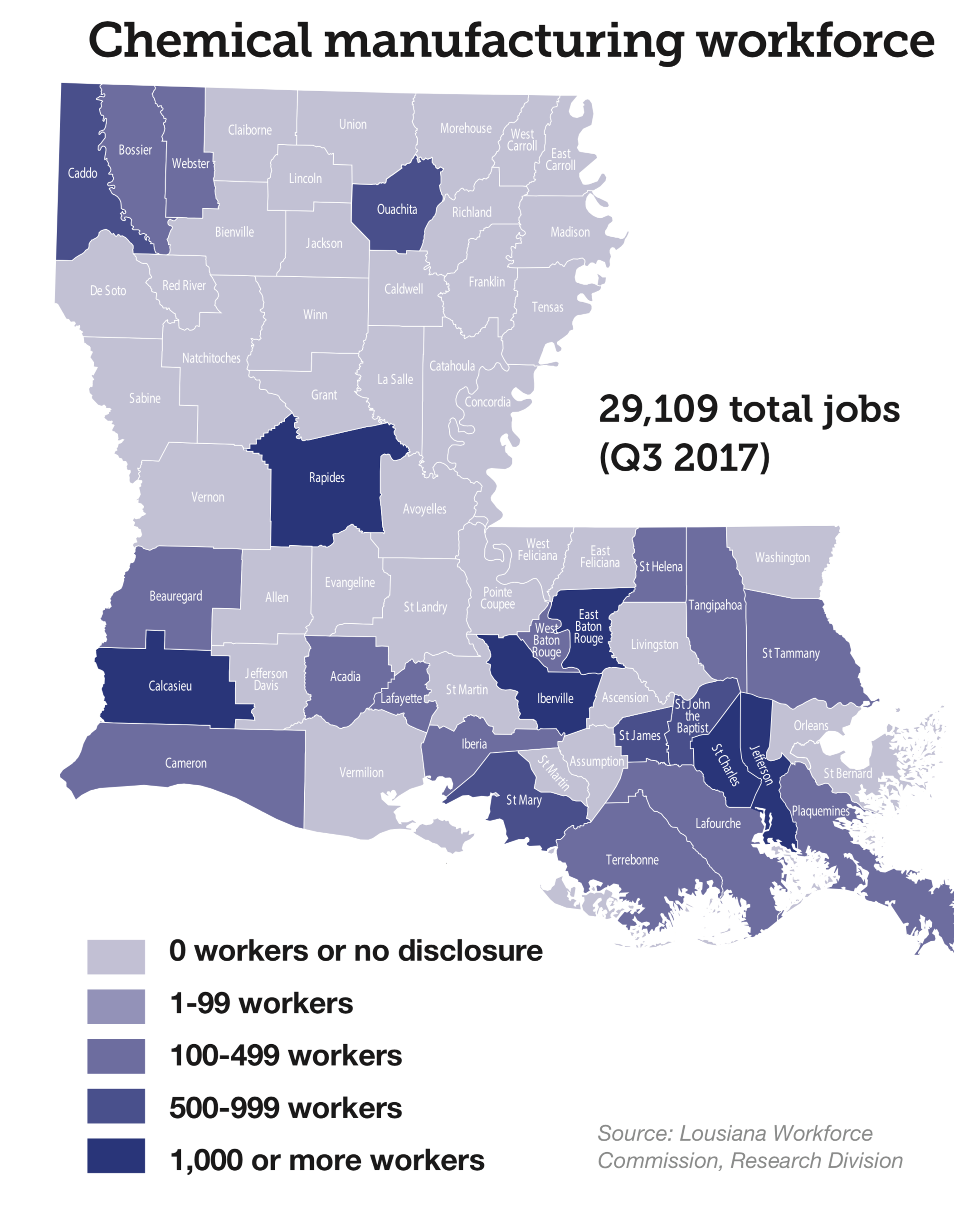
So just what does the state receive from industry? Scott says the oil and gas extraction, refining and pipeline industries directly paid $688.7 million in state taxes and fees in FY 2017, even as the extraction sector was in a serious recession. That’s primarily because Louisiana has the largest severance tax on oil and gas of any state in the country, at 12.5%.
While there are preferentially lower tax rates for those with low production, nearly 95% of the volume comes from wells subject to the full tax, and mostly from south Louisiana.
Nonetheless, an LSU Center for Energy Studies examination into the total cost of drilling and production found that, even with the higher severance, “we’re on par with other locations,” Albrecht says. “You’ve got your lease costs, labor costs, materials and everything else to factor in. The severance tax would be one of the higher components, but put it all together and we’re not a high-cost state in just operations.”
If the state sustains a boom in horizontal drilling and fracking—in areas such as Haynesville, the Austin Chalk or the Tuscaloosa Marine Shale—it won’t initially realize any tax benefits. To encourage investment in the plays, horizontal drilling and fracking operations receive a 100% exemption on severance tax for 24 months or until the cost of the well is paid. “And when the exemption period is over, the well volumes will likely be much lower than they were at the beginning,” Albrecht says. “They have very sharp decline rates, so a large share of a well’s total production comes out in the first one to two years. That’s our giveaway years.”
In regard to oil and gas royalties—collected by the Louisiana Department of Natural Resources based on barrels sold at current market price—the state feels the full impact of market fluctuations. In fiscal year 2015, royalty collections dropped from $470 million to $288 million, then dropped again to $150 million in 2016 and to $140 million 2017. In 2018, that number will likely remain at nearly $140 million. “If the price average [of oil] is a dollar more in a year, and with everything else held constant, the state might expect to get $12 million more in severance and royalty collections,” Albrecht says.
ITEP’S TRUE IMPACT
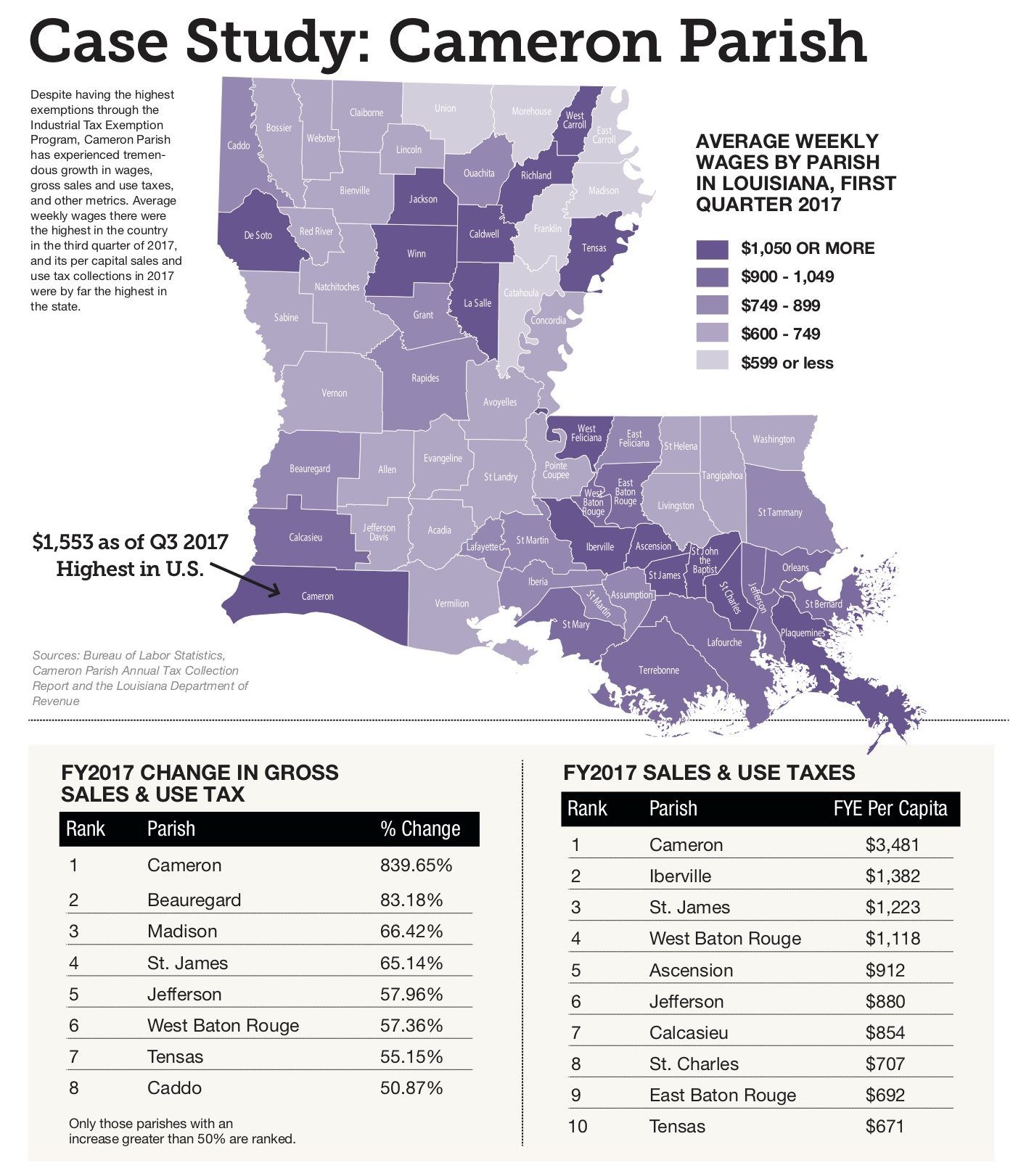 While industry spokespeople say ITEP is a critical tool for attracting petrochemical industrial investment into Louisiana, some have doubts.
While industry spokespeople say ITEP is a critical tool for attracting petrochemical industrial investment into Louisiana, some have doubts.
Albrecht feels the program has little impact on investment. “They’re not here because of ITEP,” he adds. “They’ve got to be here because this is where their supply chains are. The economic literature doesn’t support the idea that industries locate because of benefit programs. Industry is locating where land is cheap, where it can get the land and where the natural resources are. What does it cost to get my imports in and my exports out? These are the things that are by far bigger costs to them.”
Tim Harris, site manager at Eastman Chemical in St. Gabriel, strongly disagrees. He says there are several projects leaving for Texas because of instability in the ITEP program. “The companies aren’t even applying here because it’s not competitive anymore. You can look at the intake forms that LED gets and see that there’s a market drop before and after the change.”
Harris says the jobs created by new investment have a direct impact on sales tax revenue. With 110 full-time positions and about 40 resident contractors, Eastman’s payroll is about $12 million annually. “Industry pays about half of all the sales tax in the state, and the parishes where we’re heaviest are incidentally the parishes that get the most ITEP. Our industry also pays two-thirds or more of the property tax that’s collected.”
In Iberville Parish, Eastman pays nearly $1 million a year in property tax, a number that will jump by $300,000 when two ITEP contracts expire at the end of 2020-2021.
According to Loren Scott, the top eight ITEP parishes collect more property taxes per capita than the statewide average. Leading in per capita collections is Cameron Parish in southwest Louisiana. Even though it has the highest amount of ITEP exemptions, the mostly rural parish receives an average of $4,850 per person in property taxes.
Ryan Bourriaque, Cameron Parish Police Jury administrator, estimates that his parish has given up as much as $5.3 billion in property taxes through ITEP, even as taxpayers have generated $23.9 million in state sales tax for FY 2016-2017.
MIXED BAG
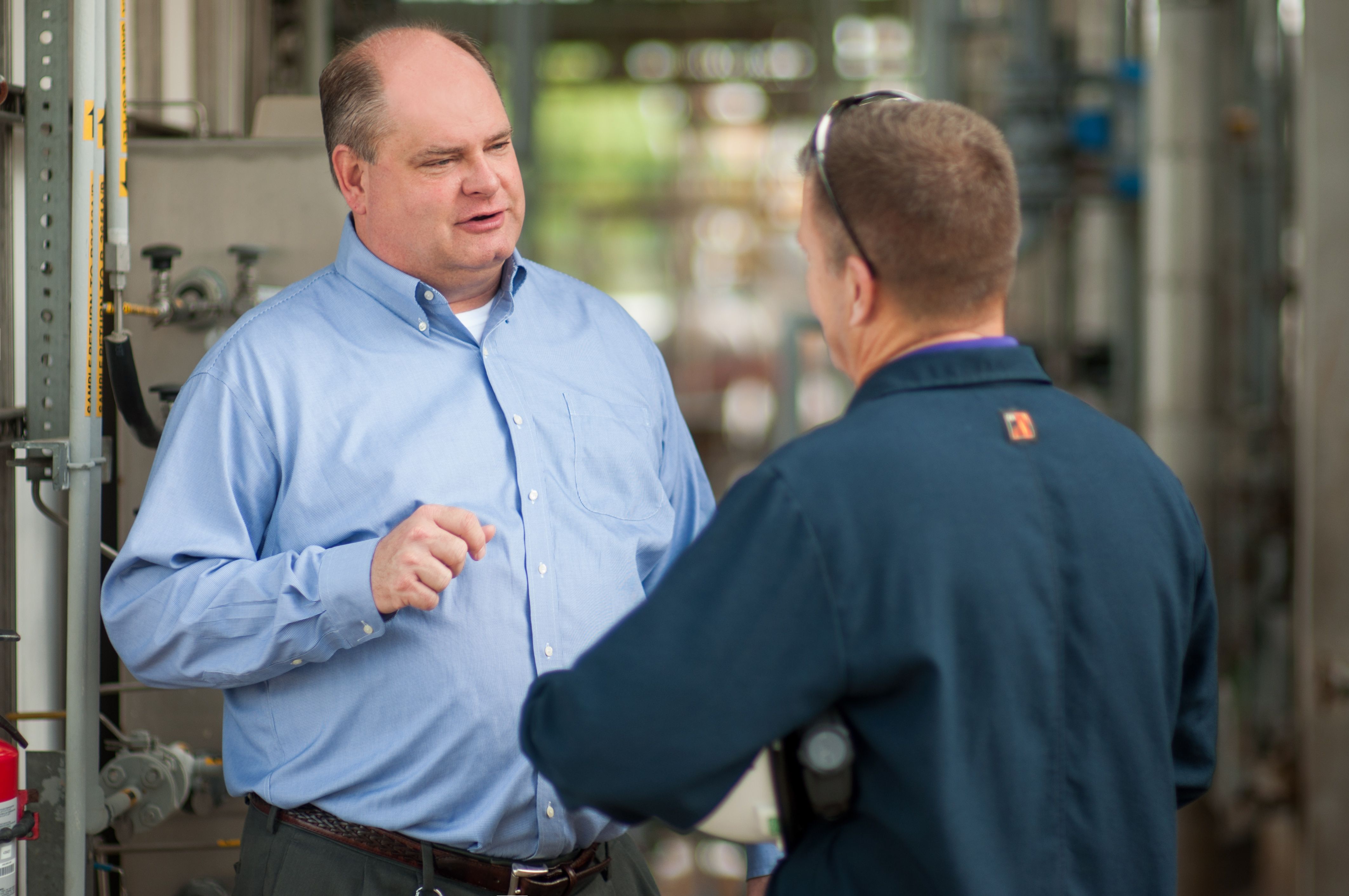
– Tim Harris, site manager, Eastman Chemical in St. Gabriel
Unfortunately, Cameron Parish remains closely tied to oil and gas, and that has put the hurt on its budget in recent years despite the jobs and taxes associated with LNG projects. Parish operating revenue in 2012 was $14.5 million; in 2016, that number had fallen to $7.8 million. “We’ve had to cut,” Bourriaque says. “We had five or six open positions in the last year that were not filled, saving us around $300,000 in salaries and benefits alone. We’ve renegotiated professional service contracts that have resulted in savings to the parish, etc. It’s unfortunate to say it this way, but we’ve had to function as if none of that [oil and gas investment] is taking place. We’ve come to the realization that the amount of funds that we once collected may not be coming back.”
Bourriaque is hanging his hopes on the booming LNG market and some innovative fundraising measures. By 2020 the parish will begin receiving property tax money from Cheniere LNG once its “initial” ITEP exemption expires. “The parish should receive its first check in 2020 for their import facility, and taxes from their export facilities will begin to roll in much later in 2026 or 2027,” Bourriaque says. Elsewhere, Cameron LNG will make its first property tax payment in 2021 for its import facility.
The parish has also looked into a “Payment In Lieu of Tax” program to address immediate infrastructure and budget gaps, but has made little progress. PILOT payments compensate a government for some or all of property tax revenue lost due to tax exemptions. “We’ve had no luck thus far in the Legislature. In 2016, House Bill 444 received the required two-thirds vote in the House, then died in committee. Then, after another year and many meetings, a revamped PILOT bill received only one vote.”
The parish has looked to other ways to finance critical projects, primarily through GOMESA (Gulf of Mexico Energy Security Act) funds. GOMESA provides revenue sharing provisions for the four Gulf oil and gas producing states of Alabama, Louisiana, Mississippi and Texas, and their coastal political subdivisions.
George Swift, executive director of the Southwest Louisiana Economic Development Alliance, says the local impact of industry—particularly LNG export projects—on local government coffers and private businesses is undeniable.
There is $65 billion in announced projects in the Lake Charles area in various stages of permitting and design, expected to create 18,000 permanent jobs.
“We’re seeing significant increases in sales tax revenue, corresponding with construction activities and the purchasing of equipment and supplies,” Swift says. Additionally, over the last four years there have been roughly 6,000 single-family or multifamily residential units constructed. Parish governments, schools and sheriff’s offices have also been the beneficiaries of the increase.
LOOKING AHEAD

At least in the near term, the state economy probably won’t see any big “ramp up.” A significantly changing oil and gas dynamic has the major players shifting their development dollars to the shale plays and away from offshore. This will continue to dampen the state’s financial coffers even if the price remains stable or increases.
“That’s the biggest problem that we’ve got,” Scott says. “What’s killing Lafayette and Houma is the fact that the Gulf hasn’t come back. If you want to drill in the Permian you walk up to a rancher and you work out a deal, and in two months you’re producing oil. If you want to drill in the Gulf it’s a six- to 10-year project before you get the first barrel of oil, and you’ve got to believe that the price is going to be up and stay up.”
Oil and gas owners have little problem identifying their biggest local obstacle—legacy lawsuits. Marc Ehrhardt, executive director of the Grow Louisiana Coalition says the state’s legal climate creates significant risk “for anyone who wants to invest. Firms are not willing to drill where there’s the risk of being hit with a lawsuit.”
The future is brighter on the petrochemical side, as companies take advantage of an abundance of locally produced natural gas and a huge price differential.
“We’ve got an ocean of natural gas right now,” Scott says. “There doesn’t seem to be any end to it, and that is the key to the growth in the chemical industry.
“Our share of the pie is growing like crazy because we’re kicking the behinds off the Europeans and the Asians in the production of chemicals. That’s why we’re having an explosion of projects in Lake Charles and along the Mississippi River.”

